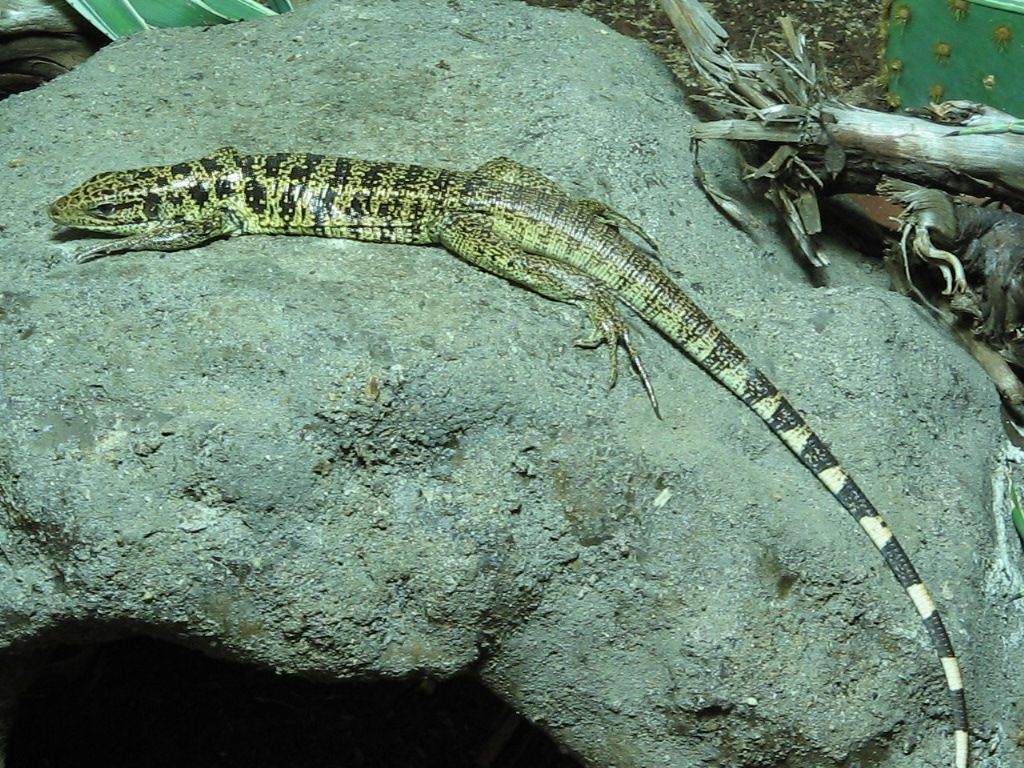- Teiidae
Taxobox
name = Teiidae

image_width = 200px
image_caption = "Tupinambis teguixin "
regnum =Animal ia
phylum = Chordata
classis = Sauropsida
ordo =Squamata
familia = Teiidae
subdivision_ranks = Genera
subdivision = See text.Teiidae is a family of
lizard s native to the New World, generally known as whiptails. The group includes the parthenogenic genera "Cnemidophorus " and "Aspidoscelis ", and the non-parthenogenic "Tupinambis ".Morphology
Teiids can be distinguished from other lizards by the following characteristics: they have large rectangular scales that form distinct transverse rows ventrally and generally small granular scales dorsallycite book |editor=Cogger, H.G. & Zweifel, R.G.|author= Bauer, Aaron M.|year=1998|title=Encyclopedia of Reptiles and Amphibians|publisher= Academic Press|location=San Diego|pages= 170-171|isbn= 0-12-178560-2] , they have head scales that are separate from the skull bones, and the teiid teeth are solid at the base and "glued" to the jaw bones. Additionally, all teiids have a forked, snake like tongue. They all possess well-developed limbs.
Teiids are all terrestrial and
diurnal , and are primarily carnivorous or insectivorous, although some will include a small amount of plant matter in their diet. They all lay eggs, with some species laying very large clutches.Parthenogenesis
Certain species of whiptail lizards have all-female or nearly all-female populations. [AAAS – [http://www.sciencemag.org/cgi/content/abstract/135/3499/212 All-Female Species of the Lizard Genus Cnemidophorus, Teiidae] ] These lizards reproduce by
parthenogenesis , and research has shown that simulated mating behavior increases fertility. For instance, one female lies on top of another, engaging inpseudocopulation . When they lay eggs, the lizard that was on bottom has larger eggs while the one on top has smaller. The lizards switch off this role each mating season. [Nerve.com – [http://www.nerve.com/Regulars/ScienceOfSex/09-19-00/09-19-00.asp The Science of Sex] . Simon LeVay, Ph.D.] The offspring are genetic clones of the mother, sparking debate as to how these lizards evolve or adapt to the environment. [American Museum of Natural History – [http://www.amnh.org/exhibitions/expeditions/treasure_fossil/Treasures/Unisexual_Whiptail_Lizards/lizards.html?50 Unisexual Whiptail Lizards] ]Genera
Family: Teiidae
* Genus "Ameiva " - Jungle-runners (about 30 species)
* Genus "Aspidoscelis
* Genus "Callopistes " - False monitors (2 species)
* Genus "Cnemidophorus " - Whiptail lizards (about 60 species)
* Genus "Crocodilurus " - Crocodile Tegu (1 species)
* Genus "Dicrodon " - Desert tegus (3 species)
* Genus "Dracaena" - Caiman lizards (2 species)
* Genus "Kentropyx " - (9 species)
* Genus "Teius " - (3 species)
* Genus "Tupinambis " - Tegus (7 species)References
*Pianka, E. R. and L. J. Vitt. 2003 "Lizards: Windows to the evolution of diversity". University of California Press. Berkeley.
Wikimedia Foundation. 2010.
